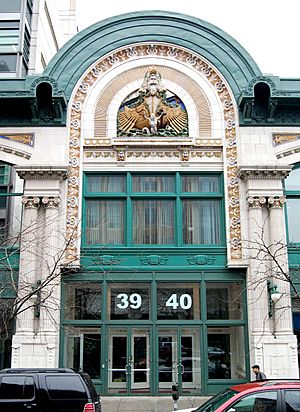Malcolm X and Dr. Betty Shabazz Memorial and Educational Center facts for kids
The Malcolm X and Dr. Betty Shabazz Memorial and Educational Center, often called the Shabazz Center, is a special place in New York City. It honors the lives of two important people: Malcolm X and Betty Shabazz. You can find it in the Washington Heights area of Manhattan. This building was once the Audubon Ballroom. A very sad and important event happened here to Malcolm X on February 21, 1965. The center officially opened on May 19, 2005. This date was also the 80th anniversary of Malcolm X's birth.
Contents
About the Shabazz Center
The Shabazz Center is a place for learning and remembering. It holds many important papers and items. These documents tell the stories of Malcolm X and Betty Shabazz. The center has a huge mural inside. This mural is 63 feet (19 meters) long. It shows different parts of Malcolm X's life. There is also a life-size bronze statue of him. He was a leader who worked for human rights.
What You'll Find Inside
The center also has six special computer screens. These are called interactive kiosks. They let you explore information about Malcolm X and Betty Shabazz. You can learn about their lives and their work. Experts from Columbia University helped create these kiosks. They wanted to make learning about these leaders fun and easy.
History of the Center
The building where the center is now had a long history. After the sad event in 1965, the Audubon Ballroom became old and worn out. By the mid-1970s, New York City owned the building. In the early 1980s, Columbia University wanted to build something new there. They planned a modern science center. This project later grew to include a research area.
Saving the Historic Building
Many people in the community did not want the old building torn down. Groups that work to save old buildings also tried to protect it. Columbia University then talked with Betty Shabazz. She asked them to save the ballroom where her husband had been shot. They reached an agreement. The new science center could be built. But the front of the Audubon Ballroom building would be saved. It would be fixed up and turned into a museum.
Building the Memorial
It took about ten years to finish the project. Many groups worked together. These included the university, the city, and historic preservation groups. The Audubon Business and Technology Center was finally completed. Betty Shabazz helped create the Malcolm X Educational Foundation. She hoped it would host meetings from around the world. She also wanted it to teach people about human rights. Plans for the center slowed down after Betty Shabazz passed away in 1997. But the project grew bigger. It was eventually finished.
Continuing Their Legacy
Today, the daughters of Malcolm and Betty Shabazz continue their family's work. They support the museum and its mission. They help to teach others about human rights and justice. The center helps keep the memory and lessons of Malcolm X and Betty Shabazz alive for new generations.


